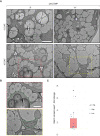The PRK/Rubisco shunt strongly influences Arabidopsis seed metabolism and oil accumulation, affecting more than carbon recycling
- PMID: 36454674
- PMCID: PMC9940875
- DOI: 10.1093/plcell/koac338
The PRK/Rubisco shunt strongly influences Arabidopsis seed metabolism and oil accumulation, affecting more than carbon recycling
Abstract
The carbon efficiency of storage lipid biosynthesis from imported sucrose in green Brassicaceae seeds is proposed to be enhanced by the PRK/Rubisco shunt, in which ribulose 1,5-bisphosphate carboxylase/oxygenase (Rubisco) acts outside the context of the Calvin-Benson-Bassham cycle to recycle CO2 molecules released during fatty acid synthesis. This pathway utilizes metabolites generated by the nonoxidative steps of the pentose phosphate pathway. Photosynthesis provides energy for reactions such as the phosphorylation of ribulose 5-phosphate by phosphoribulokinase (PRK). Here, we show that loss of PRK in Arabidopsis thaliana (Arabidopsis) blocks photoautotrophic growth and is seedling-lethal. However, seeds containing prk embryos develop normally, allowing us to use genetics to assess the importance of the PRK/Rubisco shunt. Compared with nonmutant siblings, prk embryos produce one-third less lipids-a greater reduction than expected from simply blocking the proposed PRK/Rubisco shunt. However, developing prk seeds are also chlorotic and have elevated starch contents compared with their siblings, indicative of secondary effects. Overexpressing PRK did not increase embryo lipid content, but metabolite profiling suggested that Rubisco activity becomes limiting. Overall, our findings show that the PRK/Rubisco shunt is tightly integrated into the carbon metabolism of green Arabidopsis seeds, and that its manipulation affects seed glycolysis, starch metabolism, and photosynthesis.
© The Author(s) 2022. Published by Oxford University Press on behalf of American Society of Plant Biologists.
Conflict of interest statement
Conflict of interest statement. None declared.
Figures







Similar articles
-
A RuBisCO-mediated carbon metabolic pathway in methanogenic archaea.Nat Commun. 2017 Jan 13;8:14007. doi: 10.1038/ncomms14007. Nat Commun. 2017. PMID: 28082747 Free PMC article.
-
Rubisco without the Calvin cycle improves the carbon efficiency of developing green seeds.Nature. 2004 Dec 9;432(7018):779-82. doi: 10.1038/nature03145. Nature. 2004. PMID: 15592419
-
Ribulose-1,5-bisphosphate regeneration in the Calvin-Benson-Bassham cycle: Focus on the last three enzymatic steps that allow the formation of Rubisco substrate.Front Plant Sci. 2023 Feb 16;14:1130430. doi: 10.3389/fpls.2023.1130430. eCollection 2023. Front Plant Sci. 2023. PMID: 36875598 Free PMC article. Review.
-
Decrease in leaf sucrose synthesis leads to increased leaf starch turnover and decreased RuBP regeneration-limited photosynthesis but not Rubisco-limited photosynthesis in Arabidopsis null mutants of SPSA1.Plant Cell Environ. 2011 Apr;34(4):592-604. doi: 10.1111/j.1365-3040.2010.02265.x. Epub 2011 Feb 11. Plant Cell Environ. 2011. PMID: 21309792
-
Rubisco Function, Evolution, and Engineering.Annu Rev Biochem. 2023 Jun 20;92:385-410. doi: 10.1146/annurev-biochem-040320-101244. Epub 2023 Apr 26. Annu Rev Biochem. 2023. PMID: 37127263 Review.
Cited by
-
Non-canonical plant metabolism.Nat Plants. 2025 Apr;11(4):696-708. doi: 10.1038/s41477-025-01965-3. Epub 2025 Mar 31. Nat Plants. 2025. PMID: 40164785 Review.
-
A Plate Growth Assay to Quantify Embryonic Root Development of Zea mays.Bio Protoc. 2023 Oct 20;13(20):e4858. doi: 10.21769/BioProtoc.4858. eCollection 2023 Oct 20. Bio Protoc. 2023. PMID: 37900110 Free PMC article.
-
Regulation of Oil Biosynthesis and Genetic Improvement in Plants: Advances and Prospects.Genes (Basel). 2024 Aug 26;15(9):1125. doi: 10.3390/genes15091125. Genes (Basel). 2024. PMID: 39336716 Free PMC article. Review.
References
-
- Andersson I, Backlund A (2008) Structure and function of Rubisco. Plant Physiol Biochem 46(3): 275–291 - PubMed
-
- Andriotis VM, Pike MJ, Kular B, Rawsthorne S, Smith AM (2010) Starch turnover in developing oilseed embryos. New Phytol 187(3): 791–804 - PubMed
-
- Arrivault S, Guenther M, Ivakov A, Feil R, Vosloh D, Van Dongen JT, Sulpice R, Stitt M (2009) Use of reverse-phase liquid chromatography, linked to tandem mass spectrometry, to profile the Calvin cycle and other metabolic intermediates in Arabidopsis rosettes at different carbon dioxide concentrations. Plant J 59(5): 826–839 - PubMed
-
- Asokanthan PS, Johnson RW, Griffith M, Krol M (1997) The photosynthetic potential of canola embryos. Physiol Plant 101(2): 353–360
Publication types
MeSH terms
Substances
Grants and funding
LinkOut - more resources
Full Text Sources
Research Materials

